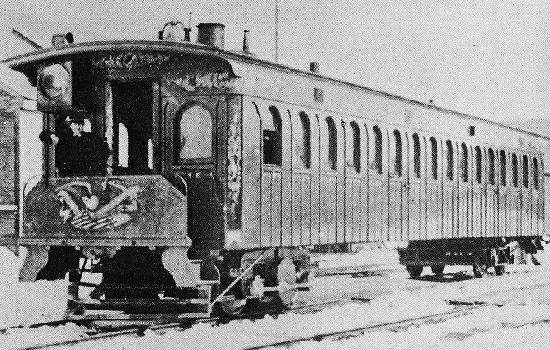Amoskeag Manufacturing CompanyAmoskeag Locomotive Works
In 1849 it received an order for a locomotive from the Northern Railroad. That was followed by two more, and by the end of the year it had built three locomotives. Soon the locomotive division—sometimes referred to as the Amoskeag Locomotive Works— became one of five departments in this very diversified company. By 1859, it had built a total of 232 [some say 234] locomotives. The Amoskeag company continued to run mills and manufacture a great many different steel products for many years. In its peak year of 1915, it employed 17,000 in 74 departments. But it could not keep up with competition (and the Great Depression) and closed in 1936. Manchester Locomotive Works
The business was begun in Mechanics Row (called by some the Mechanics Building), a 500' long brick building provided by the Amoskeag Manufacturing Company to house small-scale diversified manufactures and thus help Manchester be less exclusively dependent on cotton processing.
But the new firm apparently began building their own works, which were completed sometime the following year, in which they incorporated their business as the Manchester Locomotive Works with authorized capital of $300,000. By 1856, the works had a capacity of three locomotives per month, employing 200 men. But the financial panic that began in August 1857 and brought railroad construction to a virtual halt seems to have done the same for the Manchester Locomotive Works. Yet in 1872, Blood reportedly bought the fire engine business of the Amoskeag Company (presumably the Amoskeag Manufacturing Company), which was noted for its steam fire-engines. And in 1901, the Manchester Locomotive Company became a part of the American Locomotive Company. CONCLUSION(?)One source says Amoskeag sold its locomotive business to Manchester in 1854, and that the sale was the basis for that company. Another source says the business was sold in 1856 and was the basis for that company. A third says simply the business was sold in 1859. Our only comment is that our two oldest sources (1875 and 1885) say Manchester was started in 1853, and though they connect the two firms through Oliver Bailey, they say nothing about a sale of the locomotive business by Amoskeag to Manchester. An additional note: Corbin, Bernard and William Kerka, Steam Locomotives of the Burlington Route, (New York, NY: Bonanza Books, 1960), contains a facsimile of a report dated 1 May 1858, in which 25 locomotives are listed as manufactured by the Amoskeag Manufacturing Co., and 21 are listed as manufactured by the Manchester Locomotive Works. The Amoskeag locos date from 1851 to 1855 (mainly 1853), while the Manchester Loco Wks locos date from 1853 to 1857 (mainly 1857). The locos from the two companies are thoroughly mixed in the list, which seems to be in purely random order. [May be in order by class, which is not indicated, since names seem to be grouped; e.g., the first three are Stag Hound, Fox Hound, Grey Hound (sic), while the next two are West Wind and North Wind.] |
